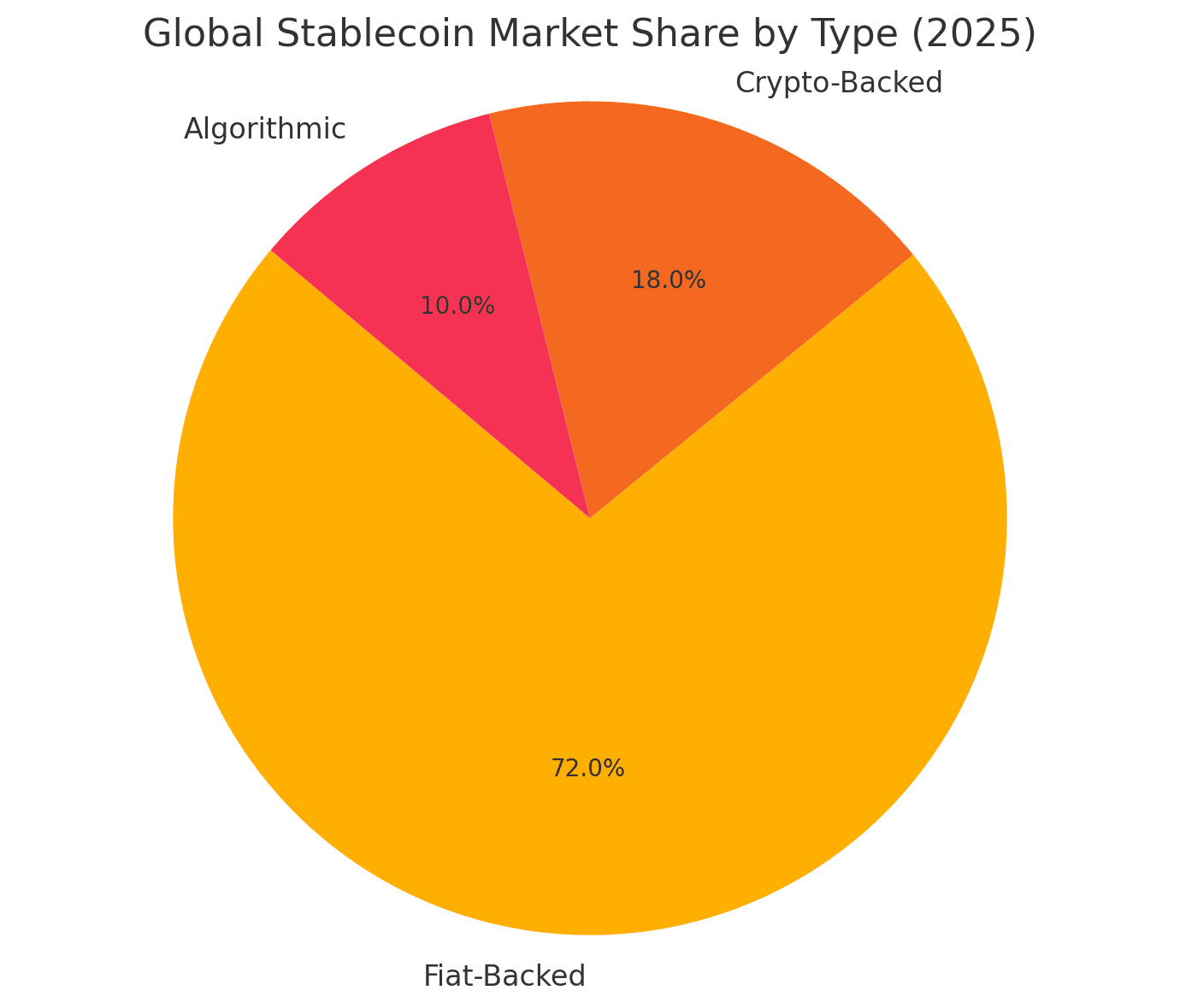Stablecoins have emerged as a vital bridge between traditional finance and the fast-evolving world of blockchain. These digital assets are designed to reduce the volatility commonly associated with cryptocurrencies like Bitcoin and Ethereum.
- Understanding Stablecoins: The Basics
- Fiat-Backed Stablecoins: Most Common and Widely Used
- Crypto-Backed Stablecoins: Collateralized with Other Digital Assets
- Algorithmic Stablecoins: Code Instead of Collateral
- Real-World Use Cases of Stablecoins
- Regulatory Landscape: Growing Scrutiny and Compliance
- Final Thoughts: Stablecoins as the Future of Digital Payments
- Glossary of Key Terms:
Pegged to stable assets such as the U.S. dollar, euro, or commodities like gold, stablecoins offer price stability while retaining the benefits of decentralized technology.
As demand for blockchain-based financial solutions continues to grow, more users and institutions are looking to understand how stablecoins work, from issuance and backing mechanisms to their use in payments, trading, and decentralized finance (DeFi).
Understanding Stablecoins: The Basics
A stablecoin is a type of cryptocurrency that is designed to maintain a fixed value relative to a reference asset. Most commonly, that reference asset is a fiat currency like the U.S. dollar. For instance, USD Coin (USDC), Tether (USDT), and Ripple’s RLUSD are all stablecoins pegged 1:1 to the dollar. Their price stability makes them ideal for use in day-to-day transactions and remittances and as a safe haven during crypto market downturns.
To understand how stablecoins work, it’s crucial to explore their backing models. There are three primary types: fiat-backed, crypto-backed, and algorithmic stablecoins.
Fiat-Backed Stablecoins: Most Common and Widely Used
Fiat-backed stablecoins are backed by real-world assets held in reserve. For example, if an issuer releases 1 million USDC, it will typically hold $1 million in U.S. dollar reserves in regulated banks. These assets may also include short-term U.S. Treasuries, ensuring liquidity and capital protection. Regular audits and public reserve attestations are often used to prove the 1:1 peg and build trust among users.

This model is straightforward, transparent, and easy to regulate, which explains its popularity among stablecoin issuers like Circle (USDC) and Tether (USDT). It also helps explain how stablecoins work in environments where financial regulators demand compliance with anti-money laundering (AML) and know-your-customer (KYC) standards.
Crypto-Backed Stablecoins: Collateralized with Other Digital Assets
Unlike fiat-backed coins, crypto-collateralized stablecoins are backed by other cryptocurrencies, such as ETH or BTC. These coins, such as DAI by MakerDAO, maintain price stability by being overcollateralized. For instance, $150 worth of ETH may be locked in a smart contract to mint $100 worth of DAI, allowing the system to absorb market volatility.
Understanding how stablecoins work in this category involves smart contracts, price oracles, and automated liquidation mechanisms. If the value of the collateral drops significantly, the smart contract may liquidate assets to preserve the peg. This decentralized model offers transparency and avoids reliance on centralized reserves, but it comes with higher complexity and risk.
Algorithmic Stablecoins: Code Instead of Collateral
Algorithmic stablecoins rely on supply and demand algorithms to maintain their peg. Rather than holding real-world or digital collateral, they adjust the token’s supply based on market dynamics. If the stablecoin trades above $1, new tokens are minted; if it trades below $1, tokens are burned to reduce supply.
While this might sound elegant, real-world experiments have shown limitations. TerraUSD (UST) was one of the most well-known algorithmic stablecoins before its collapse in 2022, which resulted in a multi-billion-dollar market crash. These events showed the risks of algorithmic systems and shaped ongoing debates on how stablecoins work safely without collateral.

Real-World Use Cases of Stablecoins
Stablecoins offer a wide range of practical applications beyond trading. In developing countries with unstable currencies, stablecoins provide an inflation-resistant store of value. Remittance companies use them to cut cross-border transaction costs and settlement times. Meanwhile, in the world of DeFi, stablecoins are used as liquidity pairs in decentralized exchanges (DEXs), collateral in lending protocols, and in yield farming strategies.
This utility is another essential angle when discussing how stablecoins work in real-world ecosystems. Because they offer near-instant, low-fee transactions, stablecoins are also being adopted by fintech platforms, central banks (as pilot models), and Web3 payment solutions.
Latest Developments in the Stablecoin Ecosystem
In July 2025, stablecoins made headlines as Ripple’s RLUSD secured its first banking integration with Switzerland’s AMINA Bank, offering institutional-grade custody and trading services. This move signifies growing trust in compliant stablecoins by regulated financial institutions.
Simultaneously, Circle’s USDC expanded its reach into Asia through a strategic partnership with Japan’s SBI Holdings, aiming to facilitate yen-to-dollar stablecoin flows. These milestones reinforce how stablecoins work not only in decentralized finance but also within the frameworks of traditional banking, proving their increasing relevance in global monetary systems.
Regulatory Landscape: Growing Scrutiny and Compliance
As stablecoins scale globally, they have caught the attention of regulators. Authorities in the U.S., EU, and Asia are working to create comprehensive frameworks governing their issuance, reserves, and audits. The European Union’s MiCA regulation and the proposed U.S. GENIUS Act both aim to classify stablecoins and bring transparency to their operations.
Understanding how stablecoins work in a regulatory context is now vital for both developers and investors. Institutions are more willing to engage with stablecoins that operate under clear legal and compliance standards.
Challenges and the Road Ahead
Despite their benefits, stablecoins face significant hurdles. Questions about reserve transparency, counterparty risk, and centralization persist. In addition, algorithmic models still struggle with price stability in the face of market volatility. Nevertheless, as newer solutions such as fully decentralized, multi-asset collateralized coins and tokenized bank deposits emerge, the stablecoin sector continues to evolve rapidly.
Looking ahead, enhanced transparency tools, third-party audits, and smart contract innovations will play a crucial role in improving how stablecoins work across use cases.
Final Thoughts: Stablecoins as the Future of Digital Payments
Stablecoins are no longer niche instruments. From cross-border payments to decentralized finance and beyond, they are becoming the backbone of the Web3 economy. Whether fiat-backed, crypto-collateralized, or algorithmic, the way how stablecoins work influences not only their adoption but also their longevity in a fast-changing digital economy.
For anyone exploring blockchain, understanding how stablecoins work is essential to navigating both traditional and decentralized financial systems. As regulation matures and innovation continues, stablecoins are poised to be among the most impactful digital tools of the next decade.
FAQs:
1. What is a stablecoin in cryptocurrency?
A stablecoin is a digital asset pegged to a stable value, like the U.S. dollar, to reduce price volatility.
2. How stablecoins work in real life?
Stablecoins work by maintaining a 1:1 peg with fiat or crypto reserves, enabling fast, low-cost, and stable digital transactions.
3. Are stablecoins safe to use?
Fiat-backed stablecoins with audited reserves are generally considered safer, while algorithmic models carry higher risk.
Glossary of Key Terms:
Stablecoin: A type of cryptocurrency designed to maintain a stable value by being pegged to a fiat currency or asset.
Fiat-Backed Stablecoin: A stablecoin backed 1:1 by fiat currencies like USD, held in reserves by regulated entities.
Crypto-Collateralized Stablecoin: A stablecoin backed by other cryptocurrencies, typically overcollateralized for stability.
Algorithmic Stablecoin: A stablecoin that uses algorithms and smart contracts to control supply and maintain its peg, without reserves.
DeFi (Decentralized Finance): Financial services built on blockchain that operate without intermediaries, using smart contracts.
MiCA Regulation: European Union legislation that governs crypto assets and stablecoin operations across member states.
Reserve Attestation: An audit or verification proving that stablecoins are fully backed by the required collateral or assets.



















































































































